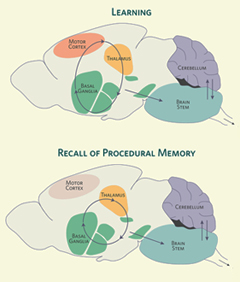Wednesday, 7 September 2016
Motor cortex is required for learning but not for executing a motor skill

The motor cortex was long thought to be the part of the brain that controlled the body’s voluntary movements. Given the plasticity of the cortex as a whole, it seemed reasonable to believe that decisive changes in the connectivity of the neurons in the motor cortex might well be associated with motor learning. Although this may indeed be the case, a study published by Risa Kawai and colleagues in the journal Neuron in May 2015 forces us to reconsider the primacy of the motor cortex in learned sequences of movements, at least in rats.
In Kawai’s experiment, the researchers taught rats to press a lever twice in succession to get a drop of juice. But there was an added twist: if the rats waited about 700 milliseconds between the first press and the second, they would get a larger drop of water.
Before the training began, the researchers divided the rats into two groups. One group had their motor cortexes removed before they started training in the task, and was never able to learn to time the two presses accurately. The second group was trained in this task and learned it after about one month, after which their motor cortexes were removed. What makes this experiment so interesting is that once the second group of rats had recovered from their surgery, they were still able to perform the task perfectly!
This result tells us that the trace of this procedural memory was not located in the motor cortex, because the rats could still execute this learned behaviour after this brain structure had been removed. So where had this memory gone? There are many other parts of the brain that are involved in body movements—the thalamus, cerebellum, brainstem, and central grey nuclei, for example—and all of them had been recognized as likely participants in the automation of movement sequences. What Kawai’s study suggests is that in the process of automating sequences of body movements, the role of the motor cortex may be to “teach ” other structures such as these, which ultimately take over the motor tasks completely. In other words, the motor cortex helps while a new motor sequence is being learned, but then is no longer needed.
A similar dynamic has been observed between two other brain structures, but with regard to semantic memory (also known as declarative memory, because we can use language to evoke our memories of our own lives and our knowledge of the world). Many studies, include those of the famous patient H.M., have shown that people who have completely lost both hippocampi in their brains still retain their oldest memories, although they cannot store any new information for more than 5 or 10 minutes.
Thus, just as procedural memories originally acquired with the help of the motor cortex are subsequently taken over by other brain structures. declarative memories originally acquired with the help of the hippocampus appear to be taken over by other (probably different) parts of the cortex. This analogy suggests a more collaborative view of the interactions among the various parts of the brain, departing still further from the idea of any “centres” that control any of its functions.
![]() The Departure of Skill Memories from Motor Cortex: Deeper Directions for Neuroscience
The Departure of Skill Memories from Motor Cortex: Deeper Directions for Neuroscience
![]() Motor cortex is required for learning but not for executing a motor skill.
Motor cortex is required for learning but not for executing a motor skill.
Body Movement and the Brain | Comments Closed








